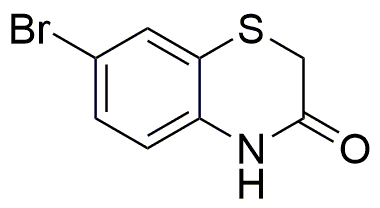7-Bromo-2H-1,4-benzothiazin-3(4H)-one is widely utilized in research focused on:
- Pharmaceutical Development: This compound serves as a key intermediate in synthesizing various pharmaceutical agents, particularly those targeting bacterial infections, due to its unique structural properties.
- Antimicrobial Research: It has shown potential as an antimicrobial agent, making it valuable in the development of new treatments for resistant bacterial strains, which is a growing concern in healthcare.
- Biochemical Studies: Researchers use this compound to study enzyme interactions and metabolic pathways, providing insights into biological processes and potential drug targets.
- Material Science: Its properties allow for applications in creating novel materials, such as polymers with enhanced thermal stability and chemical resistance, beneficial in various industrial applications.
- Analytical Chemistry: This compound is employed in analytical methods to detect and quantify other substances, aiding in quality control and regulatory compliance in pharmaceuticals and environmental monitoring.
Informations générales
Propriétés
Sécurité et réglementation
Applications
7-Bromo-2H-1,4-benzothiazin-3(4H)-one is widely utilized in research focused on:
- Pharmaceutical Development: This compound serves as a key intermediate in synthesizing various pharmaceutical agents, particularly those targeting bacterial infections, due to its unique structural properties.
- Antimicrobial Research: It has shown potential as an antimicrobial agent, making it valuable in the development of new treatments for resistant bacterial strains, which is a growing concern in healthcare.
- Biochemical Studies: Researchers use this compound to study enzyme interactions and metabolic pathways, providing insights into biological processes and potential drug targets.
- Material Science: Its properties allow for applications in creating novel materials, such as polymers with enhanced thermal stability and chemical resistance, beneficial in various industrial applications.
- Analytical Chemistry: This compound is employed in analytical methods to detect and quantify other substances, aiding in quality control and regulatory compliance in pharmaceuticals and environmental monitoring.
Documents
Fiches de données de sécurité (FDS)
La FDS fournit des informations de sécurité complètes sur la manipulation, le stockage et l’élimination du produit.
Spécifications du produit (PS)
Le PS fournit une description complète des propriétés du produit, notamment sa composition chimique, son état physique, sa pureté et les exigences de stockage. Il détaille également les plages de qualité acceptables et les applications prévues du produit.
Certificats d'analyse (COA)
Recherchez des certificats d'analyse (COA) en saisissant le numéro de lot du produit. Les numéros de lot et de lot se trouvent sur l'étiquette d'un produit, après les mots « Lot » ou « Lot de fabrication ».
Numéro de catalogue
Numéro de lot/série
Certificats d'origine (COO)
Ce certificat d'exploitation confirme le pays dans lequel le produit a été fabriqué, et détaille également les matériaux et composants utilisés et s'il est issu de sources naturelles, synthétiques ou autres sources spécifiques. Ce certificat peut être requis pour les douanes, le commerce et la conformité réglementaire.
Numéro de catalogue
Numéro de lot/série
Fiches de données de sécurité (FDS)
La FDS fournit des informations de sécurité complètes sur la manipulation, le stockage et l’élimination du produit.
DownloadSpécifications du produit (PS)
Le PS fournit une description complète des propriétés du produit, notamment sa composition chimique, son état physique, sa pureté et les exigences de stockage. Il détaille également les plages de qualité acceptables et les applications prévues du produit.
DownloadCertificats d'analyse (COA)
Recherchez des certificats d'analyse (COA) en saisissant le numéro de lot du produit. Les numéros de lot et de lot se trouvent sur l'étiquette d'un produit, après les mots « Lot » ou « Lot de fabrication ».
Numéro de catalogue
Numéro de lot/série
Certificats d'origine (COO)
Ce certificat d'exploitation confirme le pays dans lequel le produit a été fabriqué, et détaille également les matériaux et composants utilisés et s'il est issu de sources naturelles, synthétiques ou autres sources spécifiques. Ce certificat peut être requis pour les douanes, le commerce et la conformité réglementaire.


